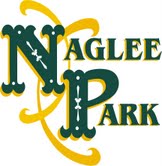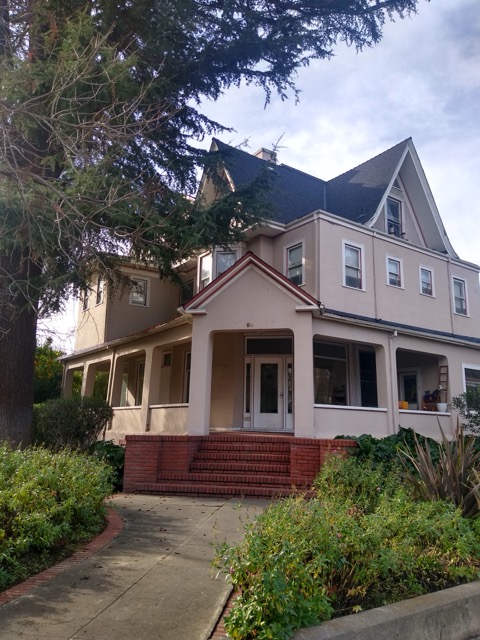The recent survey of local public monuments by the SJToday blog is a good one. What do our monuments signify and memorialize? Monuments sometimes have a story far beyond what is presented. The Naglee monument, located in St. James Park at North 2nd and St. John streets, is an example of a monument that now seems out of place and without an obvious story. This is an urban mystery worth solving. What are we missing here?

A little newspaper research reveals the monument is a tribute to California pioneer Henry Morris Naglee and was given to San Jose in 1915 by his oldest daughter, Mrs. Marie Robins, thirty years after his death. The inscription says:
This monument commemorates his service to the country
in the Mexican-American and Civil War
Naglee’s military service is mentioned first. He is shown in the uniform of a Brigadier General of the Union Army. Neither of his daughters were born when he served so they had no firsthand knowledge of his service. Actually, Naglee was not a career soldier although he graduated from the US Military Academy at West Point. But he was intensely patriotic and proud of his service. He served in several campaigns during his four years’ service in the Civil War. He was most proud that his men personally awarded him a gold medal for leading them safely through the three-day Battle of Fair Oaks during the Peninsula Campaigns. His wounds were minor although he lost three horses due to the fighting. None of that story is mentioned on the monument.
Naglee arrived in California in 1847 and soon established a home in San Jose. He acquired hundreds of acres in Santa Clara Valley and the 35,500-acre Rancho Pescadero near Stockton. His work as a San Francisco banker helped finance development in San Jose. The inscription notes his civic activities:
His public spirit in promoting the welfare
of this city and valley
This brief line does not mention his business leadership in San Francisco, establishing California’s first bank, building the first permanent business building in San Francisco and organizing the First California Troop, the early militia now known as the California National Guard. Recent research reveals Naglee was Santa Clara Valley’s first trained civil engineer. He was a business leader in both San Francisco and San Jose, helping acquire Alum Rock Park for San Jose. He donated Monterey pines to plant along the road leading to the entrance of the park. If he was so important in San Francisco, why is the monument in San Jose? Again, the answer is found in research. Henry M Naglee considered San Jose his home. It was his legal address and a place he loved.
His leadership in the development of agriculture
and his efforts to secure commercial freedom
for the people of California
This line of the tribute would have been obvious to his San Jose neighbors in the day when Santa Clara Valley was becoming known as the Garden of Eden. Naglee was an experimental horticulturist, importing hundreds of trees and exotic plants from around the world to determine what would grow best in Santa Clara Valley. He established an eighty–acre vineyard on his estate in a quest to manufacture a colorless brandy. His showplace garden was open to the public. It was Naglee who demonstrated to the world that anything could be grown in Santa Clara Valley. Although he invested in many agricultural efforts such as cattle breeding and sugar beet development, it is not clear that these efforts have resulted in “commercial freedom.” His lobbying efforts on behalf of the wine and brandy industry have benefitted the growers and vintners and may be recalled by these final words.
The monument itself was a gift to San Jose by Mrs. Marie Naglee Robins, his oldest daughter. It was presented as Mrs. Robins was completing duties as executor of Naglee’s estate. The family company, Naglee Park Improvement Corporation (NPICo) that developed Naglee Park was being dissolved, and other properties sold. The monument provided closure to the family’s time in California. It was a farewell gift by Marie Robins to her California birthplace and hometown, San Jose, before she returned to Philadelphia, then her current home.
Mrs. Marie Naglee Robins personally commissioned the finest work available. The designer of the monument was architect Paul Philippe Cret, head of the School of Architecture at the University of Pennsylvania. The sculptor for the bas-relief bronze plaque was Canadian Robert Tait McKenzie, creator of many prize winning Civil War statues. San Jose has few monuments created by nationally significant artists.
The Naglee monument is the only reminder in San Jose that California played a significant role in the War of the Rebellion. California gold helped provide critical financing for the Union effort. In 1860, the onset of the Civil War, when the average life expectancy in America was 39 years, Naglee, an old man of forty-five, went to battle. He returned to the East Coast, traveling by boat and via the Isthmus of Panama, through the Caribbean to Philadelphia, not an easy trip. His actions sent a message to his neighbors, demonstrating his support to preserve the Union. When the wealthiest man in town travels thousands of miles to enlist, it is a powerful demonstration of patriotism.
Naglee returned to California at the end of the War and married for the first time at the age of fifty. His charming young bride died four years later, leaving him with two young daughters. He never remarried. Naglee’s reputation for generosity was overshadowed by two sensationalized breach of promise suits, one in 1865 and the other in 1877. Naglee eventually prevailed in both cases. Both of his daughters married and had families; their homes were in the Philadelphia area. Naglee died in 1886 and the San Francisco newspapers noted his funeral was the largest memorial service and parade held to that time.
After the development of the Naglee Park subdivision (1902) and the presentation of the Naglee monument, the Naglee name began to fade, now remembered in San Jose only on street signs and this imposing monument. The location of the monument in St. James Park is a reminder of Naglee’s one-time civic and economic importance to the community. Henry Morris Naglee was the person who quietly developed much of early San Jose, from Naglee Avenue in the Rose Garden to northern Willow Glen. He was a banker whose quiet investments helped build San Jose. This monument forces the viewer to read between the lines because there is one critical piece of information that is missing – Naglee was trained as a civil engineer. He is San Jose’s earliest professional engineer. Since Santa Clara Valley is a community built on engineering expertise, this information now makes all the difference.
Sources
- Frederic Hall, History of San Jose, 1870.
- Patricia Loomis, Signposts, 1982.
- San Jose Mercury, Nov.15, 1915.
- Picture of General Naglee – https://www.loc.gov/pictures/item/2018667286/, Public domain, via Wikimedia Commons


Leave a Reply